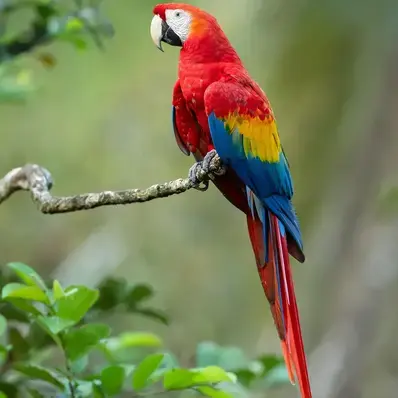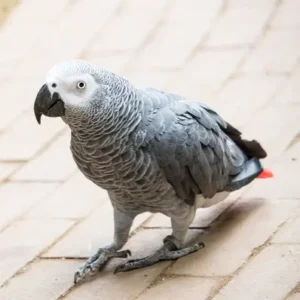History/Origin
The Amazon Parrot’s scientific name is Amazona. Amazon Parrots have deep roots in the lush forests of Central and South America. Indigenous communities cherished them for their beauty and cleverness. Explorers brought them to Europe. They became prized as pets and performers due to their colorful feathers and mimicry abilities.
Fascinating humans with their vocal talents and vibrant personalities, Amazon Parrots faced challenges like habitat loss and overexploitation. However, efforts to conserve their habitats and regulate their trade ensure their continued presence. This is both in their native lands and as beloved companions worldwide.
Personality
Amazon Parrots are naturally social and thrive on interaction, often forming strong bonds with their flock or human companions. Known for their curiosity and vocal abilities, they use a variety of sounds to express their feelings and needs, and can even mimic human speech.
These birds are intelligent and adaptable, with impressive learning and problem-solving skills. They are also emotionally expressive, reacting to changes in routine with visible signs of joy, excitement, or discomfort. With strong playful instincts, Amazon Parrots engage in activities that stimulate their minds and bodies, essential for their overall well-being.
Physical Appearance
Let’s explore the visual characteristics of the Amazon parrot.
- Body Size:
Amazon Parrots vary in size, but they typically range from medium to large. They can measure anywhere from 10 to 18 inches (25 to 46 centimeters) in length, depending on the species. Some are smaller, comparable to a small pigeon, while others can be as large as a crow.
- Coat Color:
The predominant color of Amazon Parrots is green, which covers most of their body feathers. However, they often exhibit splashes of vibrant colors like blue, yellow, red, or purple on their wings, heads, or tails.
Amazon Parrot Lower Classifications
The lower classifications of the Amazon parrot include various species within the genus Amazona. Some examples of Amazon parrot types are:
- Green-cheeked Amazon (Amazona viridigenalis)
- Blue-fronted Amazon (Amazona aestiva)
- Double Yellow-headed Amazon (Amazona oratrix)
- Yellow-crowned Amazon (Amazona ochrocephala)
- Yellow-naped Amazon (Amazona ochrocephala auropalliata)
- Mealy Amazon (Amazona farinosa)
- Lilac-crowned Amazon (Amazona finschi)
- Red-lored Amazon (Amazona autumnalis)
- White-fronted Amazon (Amazona albifrons)
- Orange-winged Amazon (Amazona amazonica)
Gender Differences
Male and female Amazon Parrots often have subtle differences in their physical characteristics and behaviors. Here’s what to look for:
- Physical Features: In some species, males have brighter feathers or markings than females, but it varies. So, telling them apart by looks isn’t always easy.
- Behavioral Traits: Males might be louder and more territorial, especially during mating season when they’re trying to find a mate. Females might start nesting and protect their space.
- Mating Rituals: For mating rituals, males typically do fancy moves like spreading wings or dancing to impress females. Females might respond by making sounds or showing they’re interested.
Feed/Nutrition
Let’s explore the dietary habits and nutritional needs of both wild and pet Amazon Parrots.
Wild Amazon Parrot Diet
In the wild, Amazon Parrots eat a variety of foods. Their diet includes fruits, seeds, nuts, flowers, and vegetation found in their natural habitats. They search for food in trees and on the ground, foraging for what’s available in their environment.
Pet Amazon Parrot Diet
Here is what your pet Amazon Parrot would enjoy the most in their diet:
- Offer them a mix of fresh fruits like apples, grapes, and bananas, and veggies such as carrots, broccoli, and leafy greens
- Include high-quality parrot pellets with important vitamins and minerals in their daily meals
- Make sure they always have fresh, clean water available
- Avoid giving them foods high in fat, sugar, or salt, as these can hurt their health
- A varied and healthy diet helps keep your pet Amazon Parrots happy and living longer
Amazon Parrot Health
Amazon Parrots, like all pets, are susceptible to certain diseases. Here are some common ones, along with their causes and preventive measures:
Respiratory Infections
- Causes: Exposure to drafts, poor ventilation, vitamin A deficiency, or contact with sick birds can lead to respiratory infections.
- Preventive Measures: Keep your parrot’s living area clean and well-ventilated. Avoid exposing them to drafts or sudden temperature changes. Quarantine new birds before introducing them to your existing flock.
Psittacosis (Parrot Fever)
- Causes: Psittacosis is a bacterial infection caused by Chlamydia psittaci. It can be transmitted to humans.
- Preventive Measures: Practice good hygiene, including regular handwashing after handling your parrot. Keep their living area clean, and provide a nutritious diet to maintain their immune system.
Obesity
- Causes: Overfeeding and lack of exercise can lead to obesity in Amazon Parrots.
- Preventive Measures: Provide a balanced diet with appropriate portion sizes. Encourage regular exercise and mental stimulation through toys and playtime.
Feather Plucking
- Causes: Feather plucking can be caused by stress, boredom, or underlying health issues.
- Preventive Measures: Identify and address the underlying cause of stress or boredom. Provide environmental enrichment and social interaction to keep your parrot mentally stimulated.
Beak and Feather Disease (PBFD)
- Causes: PBFD is caused by a viral infection and can lead to feather loss, beak abnormalities, and immune system suppression.
- Preventive Measures: Quarantine new birds before introducing them to your flock. Practice good hygiene and avoid sharing grooming tools between birds.
Gastrointestinal Disorders
- Causes: Poor diet, stress, or bacterial infections can lead to gastrointestinal disorders in Amazon Parrots.
- Preventive Measures: Provide a balanced diet with fresh fruits, vegetables, and high-quality pellets. Keep their living area clean and reduce stressors in their environment.
Regular veterinary check-ups, a nutritious diet, proper hygiene, and a stimulating environment are important for preventing and managing common diseases in Amazon Parrots. Early detection and treatment can help your feathered companion live a long and healthy life.
Care and Grooming Practices
To keep your Amazon Parrot healthy, focus on their home, cleanliness, and physical well-being.
Make sure their cage is big enough and place it in a quiet spot so they feel safe and cozy. Offer your parrot toys and perches to help keep their beak healthy. Avoid rough surfaces that could hurt their beak.
Keep their cage clean by removing poop and old food regularly. Give them a way to bathe, either in a dish or with a gentle mist. Keep their living area away from drafts and extreme temperatures. Aim for a comfortable range between 65 °F to 85 °F.
Check their beak and nails and trim them if they get too long. Spend time with them, playing and talking, to keep them happy and active. Take them to the vet for check-ups to catch any problems early.
Amazon Parrot Rescue Groups
Amazon Parrot rescue groups are dedicated to the welfare and rehoming of these birds in need of care and support. Here are some rescue organizations that specialize in helping Amazon Parrots:
Where to Buy The Amazon Parrot?
Visit the following online websites where you can find Amazon Parrots for sale:
Interesting Facts About The Amazon Parrot
Here are some facts that you will find interesting about these lovable parrots:
- Amazon Parrots communicate through various body language cues, such as head bobbing, tail flaring, and raised crests, reflecting their emotional states.
- They reach sexual maturity at different ages depending on the species, with some becoming sexually active as early as 2 to 4 years old.
- Like other birds, Amazon Parrots undergo a molting process where they shed old feathers and grow new ones.
- When initially found, they were named “Kriken,” a French term meaning “screechers”
- Similar to many parrots, Amazon Parrots are monogamous, forming lifelong bonds with one mate.
Best For
Amazon Parrots make great pets for those who are dedicated to providing them with proper care, attention, and stimulation. However, potential owners should be aware of their long lifespan and the commitment required to meet their social and environmental needs.
Top Names
| Male Amazon Parrot Names | Female Amazon Parrot Names |
| Rio | Luna |
| Charlie | Bella |
| Max | Coco |
| Rocky | Rosie |
| Jasper | Lily |










